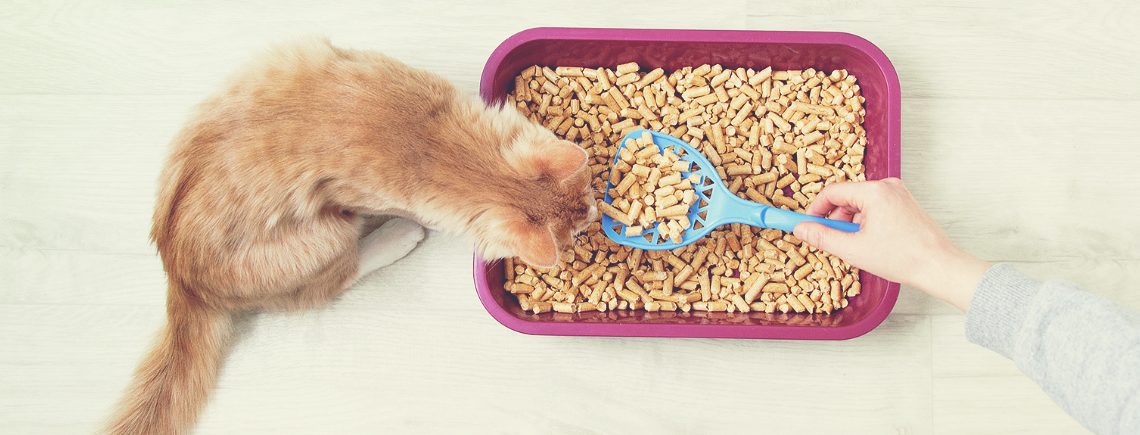Choosing a Cat Litter
One of the most important things on your to-do list as a cat-parent is choosing the right litter for your kitty. Sounds easy, right? With many different options and a wide variety of choice available, picking a litter can often seem like a formidable task.
Finding the right cat litter is important as it can help reduce feline stress and prevent litter box issues like urinating outside of the litter box. The last thing you want is for your cat to reject the litter and you finding accidents throughout the house.
In this blog post, we’ll break down the different kinds of cat litter, how to choose the right one for your kitty, and what to do if you’re switching litter.
The Types of Cat Litter
Clumping or Non Clumping
Clumping litter will absorb moisture, causing it to form a ‘clump’ in the litter tray when it gets wet. This makes it easier to scoop out. The rest of the litter stays dry, so it’s not necessary to change all the litter in your tray as often.
Non-clumping litter does not form clumps when soiled, so while solid waste can be removed easily, you will need to empty your litter tray completely when refreshing. This option is best for multi-cat households where you may find yourself changing litter frequently.
Scented or unscented
Scented litters are designed to mask litter box odours. It can help reduce the unpleasant smell in your home.
Unscented cat litter absorbs the smell rather than masking it by using ingredients such as carbon and natural plant extracts. This is helpful if your cat is very sensitive to smell.

Odour-Reducing
Odour reducing litters have been developed to trap nasty odours and can be particularly useful when using a litter tray rather than hooded cat toilet. They are available in a choice of scented and unscented options, depending on your personal preference.
Eco-friendly
Often made from recycled paper, woodchip or vegetable fibres, these environmentally friendly options are often flush-able, biodegradable and compostable making them a great choice for those looking to make the move from silicone or clay based cat litter.
What is Cat Litter Made Of?
| Clay | Clay based litter is great for easy clean up and odour control. It is available in both clumping and non-clumping varieties. |
| Plant Based | Some examples of natural cat litter are corn, bamboo, wheat, coconut or walnut. They are usually biodegradable, eco-friendly, flushable and compostable. They are absorbent with excellent odour control. |
| Silica Gels | Absorbs liquid and smells, reducing the need to change as frequently. Faecal waste will still need to be removed daily. |
| Paper | Fully biodegradable and a natural absorbent of cat litter. It is dust free and great for kitties recovering from surgery. It may need more frequent changes than other litters |
| Wood | Wood based litter is environmentally friendly and dust-free. It can also be used for landscape mulch and composting. |
What to Consider when Choosing a Cat Litter
Each cat will have their own preference when it comes to litter. Finding out which litter works best for your cat and home may require some trial and error, so don’t be afraid to experiment until you find the right one for your cat. If possible, discuss with the previous owner or adoption shelter what kind of litter your cat was using to help you get a better idea of their preferred litter.
- Allergies
Just like humans, cats can develop allergies, with kittens and senior cats most at risk. Keep an eye out for possible allergens found in your cat litter such as silica, dust and fragrances. Pay close attention to how they act after using their litter box and if you suspect they have an allergy, contact your vet immediately. For dust-free litter options, try VAN CAT Classic Cat Litter

- Comfort
If your cat has been declawed, the litter may cause them pain in their claws. This can lead to litter box avoidance. In this case, a softer litter will be the better option for your kitty, such as KITTYFRIEND Wood Pellets Litter and SANICAT Classic Marseille Soap.
- Environmentally-conscious
If you’re looking for ways to be a more eco-friendly cat parent, there are many earth-friendly cat litters available, such as Nature’s Eco, and WOODY Cat Litter.
- Age
If you own a kitten, avoid using clumping litters as they can cause gastrointestinal upset if ingested. Hold off using them until they are at least 4 months old. In the meantime, check out our kitten friendly litters such as KITTYFRIEND Antibacterial Non-Clumping.
Switching Litters
When transitioning litters, try make the change as gradual as possible. A good technique is to leave the new litter box with the older litter. Continue to do this until your cat is comfortable using the new litter.
Any questions? We would be more than happy to help.
There are range of different cat litters available and our team in-store are available to help you to find the one that is most suitable to your kitty’s needs.

